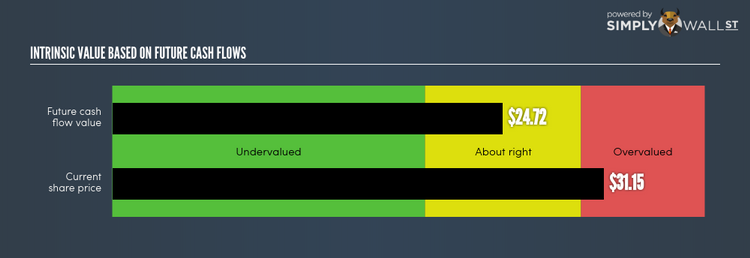Is Health Insurance Innovations Inc (NASDAQ:HIIQ) Expensive For A Reason? A Look At The Intrinsic Value

One of the most difficult industry to value is insurance, given that they adhere to different rules compared to other companies. Industry-specific factors, such as gross written premiums are crucial in understanding how insurance companies make money. Looking at line items such as book values, in addition to the return and cost of equity, may be fitting for gauging HIIQ’s true value. Today we will look at how to value HIIQ in a reasonably useful and uncomplicated approach. View our latest analysis for Health Insurance Innovations
Why Excess Return Model?
Two main things that set financial stocks apart from the rest are regulation and asset composition. Financial firms operating in United States face strict financial regulation. Moreover, insurance companies usually do not have significant amounts of physical assets on their books. As traditional valuation models put weight on inputs such as capex and depreciation, which is less meaningful for finacial firms, the Excess Return model places importance on forecasting stable earnings and book values.
Deriving HIIQ’s Intrinsic Value
The central assumption for this model is, the value of the company is how much money it can generate from its current level of equity capital, in excess of the cost of that capital. The returns in excess of cost of equity is called excess returns:
Excess Return Per Share = (Stable Return On Equity – Cost Of Equity) (Book Value Of Equity Per Share)
= (25.07% – 8.49%) * $6.59 = $1.09
We use this value to calculate the terminal value of the company, which is how much we expect the company to continue to earn every year, forever. This is a common component of discounted cash flow models:
Terminal Value Per Share = Excess Return Per Share / (Cost of Equity – Expected Growth Rate)
= $1.09 / (8.49% – 2.47%) = $18.13
Combining these components gives us HIIQ’s intrinsic value per share:
Value Per Share = Book Value of Equity Per Share + Terminal Value Per Share
= $6.59 + $18.13 = $24.72
Relative to the present share price of $31.15, HIIQ is overvalued. This means HIIQ isn’t an attractive buy right now. Pricing is one part of the analysis of your potential investment in HIIQ. Analyzing fundamental factors are equally important when it comes to determining if HIIQ has a place in your holdings.
Next Steps:
For insurance companies, there are three key aspects you should look at:
Financial health: Does it have a healthy balance sheet? Take a look at our free bank analysis with six simple checks on things like leverage and risk.
Future earnings: What does the market think of HIIQ going forward? Our analyst growth expectation chart helps visualize HIIQ’s growth potential over the upcoming years.
Dividends: Most people buy financial stocks for their healthy and stable dividends. Check out whether HIIQ is a dividend Rockstar with our historical and future dividend analysis.
For more details and sources, take a look at our full calculation on HIIQ here.
To help readers see pass the short term volatility of the financial market, we aim to bring you a long-term focused research analysis purely driven by fundamental data. Note that our analysis does not factor in the latest price sensitive company announcements.
The author is an independent contributor and at the time of publication had no position in the stocks mentioned.

